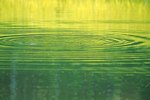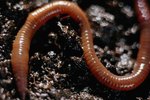
Leeches are worms that prey on other animals, whether by eating them or sucking their blood. Throughout the world more than 650 leech species have been identified. They all require moisture to live, but leeches may live in freshwater, in saltwater or on land.
Freshwater Leeches
Parasitic freshwater leeches are the ones we most commonly think of when we hear the world leech. These animals dwell in the shallow waters of ponds, streams, lakes and rivers. Macrobdella decora, known as the North American leech, is a particularly colorful leech with orange spots down its sides and an orange belly. It's pretty to look at but not particularly pretty to have stuck on your skin, and is very common across the continent. Common freshwater leeches like Hirudo medicinals are used medicinally, for example to increase blood flow to a reattached appendage. These leeches are medicinally useful because their saliva contains anesthetic and anti-coagulant, which keeps blood flowing painlessly from the patient.
Marine Leeches
Marine leeches feed on other aquatic life forms that share the murky ocean depths. Leeches can be found feeding in just about all the world's oceans. Notostomum laeve is the first recorded marine leech species found in North America. It lives in the icy waters of the Arctic Ocean. Leech expert Dr. Mark Siddall has noticed that marine leeches by species feed on either bony or cartilaginous fish. Members of one leech species are never found feeding both types of fish.
Terrestrial Leeches
Some leeches manage to live on land rather than in water, but only if the environment is high in humidity -- all leeches need high moisture to maintain their protective covering of mucus. Land leeches live in the moist soils of rain forests in places like South America, Africa and Asia. The extremely rare Americobdella valdiviana in Chile is a terrestrial leech that feeds on earthworms. They and all other terrestrial leeches are specially adapted to life on land but can survive submerged in water for short periods. If conditions are quite dry they can burrow in the mud and aestivate there until moisture revives them.
Leech Mouth Types
Aside from their geographic location and diet, leeches are differentiated by their mouths. Jawed leeches (Gnatbobdellida) have teeth they use to latch onto their prey for bloodsucking. Jawless leeches (Rhyncobdellida) use a proboscis -- or long, thin mouthpart -- to pierce their victims and draw blood. These leeches most typically feed on other small aquatic animals like snails and other worms. The giant Amazonian leech (Haementeria ghilianii), which grows up to 18 inches long, is an example of a jawless leech. Worm leeches (Pharyngobdellida) do not suck blood. They eat small prey they can take into their mouths whole, like insects and fish eggs.
References
- PBS: Red Gold: The Epic Story of Blood: Early Practices -- Leeches
- Leeches; Patricia L. Kite
- Leeches: Waiting in the Water; Barbara A. Somervill
- PBS NOVA Science Now: Leeches: Expert Q&A
- JRank.org: Leeches: Hirudinea - Giant Amazonian Leech (haementeria Ghilianii): Species Accounts
- American Museum Novitates: Leech Collections From Chile Including Two New Species of Helobdella (Annelida: Hirudinida)
- The Journal of Parasitology; First North American Record of the Marine Leech Notostomum laeve (Annelida: Hirudinea); Eugene M. Burreson and J. Richard Arthur
Resources
- Smithsonian National Museum of Natural History: Department of Invertebrate Zoology -- Haementeria ghiliani de Filippi, 1849 (Giant Amazon Leech) "Grandma Moses"
- Marine Parasites: Marine Leeches
- Classification and Checklist of the Leeches (Phylum Annelida: Class Clitellata: Subclass Hirudinida) Occurring in North America North of Mexico
Photo Credits
-
Michael Blann/Digital Vision/Getty Images
Writer Bio
Madeline Masters works as a dog walker and professional writer. In the past she has worked as a fitness columnist, fundraising copywriter and news reporter. Masters won two Pennsylvania Newspaper Association Awards in 2009. She graduated from Elizabethtown College with a Bachelor of Arts in English.




